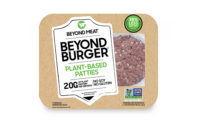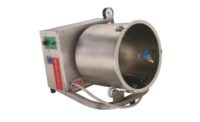Marinating is playing a major role in driving convenience-minded consumers to the meat case.
The ability to get pre-flavored proteins at a lower cost than when dining out is spurring more shoppers to purchase the value-added products, and merchandisers are responding by expanding their arrays of options.
Yet suppliers and retailers still must surmount operational challenges, including food safety and efficiency issues, and target the key shopper segments if they are to generate maximum activity. Such consumers include the large base of Millennial and Generation X buyers who range in age from their late teens to early 50s and often want newer and bolder flavors and easy-to-prepare meals.
Many of the time-constrained shoppers are from households with two working parents and often lack the cooking skills of previous generations.
“Younger shoppers are an important market for value-added, but to date, Millennials’ spend per buyer for meat lags behind that of their older counterparts,” according to the Power of Meat 2017 report. “It is important that the price differential is commensurate with the perceived convenience benefits of value-added. Additionally, continuous flavor innovation is important to stay ahead of food fatigue and on trend with popular cuisines.”
Valued-added proteins, such as pre-marinated and pre-seasoned meat and poultry, typically are more expensive and have higher margins than traditional selections.
The Power of Meat 2017 is published by the Arlington, Va.-based Food Marketing Institute (FMI) and the Washington, D.C.-based North American Meat Institute (NAMI).
“Americans are increasingly moving to flavorful meats and poultry,” says Anne-Marie Roerink, principle of 210 Analytics, a San Antonio-based marketing research and marketing strategies firm that collected data for the Power of Meat 2017. “Shoppers are spicing up their meals with pre-marinated meat in the value-added section as well as fully cooked options with many new flavor varieties.”
With spicy and highly flavorful foods driving sales throughout the supermarket, Roerink says pre-marinated proteins provide a great opportunity for retailers to boost meat and poultry activity with flavor rotations, cross-promotions with spice mixes and bottles of marinates, and by offering meal coupon deals in the meat department.
Focus on the flavors
To offer the optimal marinated proteins in each retail location, merchandisers should track the flavors that are popular at local foodservice outlets, says Diana Sheehan, director of retail insights for Kantar Retail, a Boston-based research and consulting firm.
“Retailers need to start thinking through what is hot outside of the store and the flavor trends that shoppers care about,” she says, noting that Middle Eastern and nuanced barbecue selections are becoming more prevalent.
It is important for retailers to offer trendy and unique flavors and to work with processors to develop appealing options if they are to boost interest and awareness, Sheehan says.
Merchandising all available selections concurrently, however, could cause major operational problems, including the prospect of greater spoilage and shrink if retailers aren’t able to sell the entire inventory prior to the expiration dates on meat and poultry packages, she says.
“Retailers have to approach marinated meats with a strategy that allows them to optimize SKUs,” Sheehan says. “As the space becomes more complex, it will become increasingly important to look at it quantitatively.”
It also is crucial for retailers to leverage the marinade flavors that are most likely to excite shoppers, she says.
“Retailers that just stick with the simple basics are not going to inspire people who are leaning towards foodservice to instead cook at home,” Sheehan says. “They need to be creative and find flavor profiles that are very specific to their local shoppers and which come from local producers.”
A changing chicken sector
Marinade options include Mediterranean, Asian and Southwest flavors, which already are becoming more prevalent in chicken products, says Tom Super, vice president for the Washington, D.C.-based National Chicken Council (NCC).
“The use of marinades is an excellent way to extend the reach of chicken,” he says. “As a broader array of consumers continue to find boneless, skinless chicken thigh meat a more appealing part of their at-home menus, more dark meat chicken products will be marinated.”
Demand for marinated chicken also will increase as merchandisers make it easier for consumers to prepare meals, Super says. Examples include incorporating marinated poultry in the cook-in-bag packaging that already is popular with vegetables.
“Transferring the technology to marinated chicken will require a bit of a breakthrough but it will happen because households with two working parents don’t want the fuss, mess and time that can be involved in preparing regular marinated foods,” he says.
Value-added pork selections, meanwhile, also are expanding as the protein’s subtle flavor makes it ripe for marinating, says Patrick Fleming, director of market intelligence and innovation for the Des Moines-based National Pork Board (NPB).
Seasonal flavors, such as cranberry and apple for the holidays and barbecue selections for the summer grilling season, are becoming prevalent, he says, noting the options also can generate strong activity during key promotional periods.
“Restaurants drive incremental sales with limited-time offers and there is an opportunity for retailers to do the same with marinated flavors,” Fleming says. “As they call attention to the selections, retailers also can create a sense of urgency because of the limited time availability.”
Pro-active merchandisers can keep the category vibrant by rotating flavors, which includes offering traditional options such as lemon pepper, garlic and teriyaki, as well as popular foodservice offerings including chili lime, chipotle, sriracha and bourbon.
An increase in the amount of protein containing marinates also will bolster interest, Fleming says, noting that pork selections are expanding from the traditional tenderloins to whole loins, loin fillets, shoulders and chops.
Many Baby Boomers, he adds, also will embrace proteins with marinades if the packages are small enough to accommodate one- or two-person households as “leftovers are not popular.”
“The key is to keep people shopping at the marinated meat section by having new selections that retailers promote regularly throughout the year and ensuring that the faster-selling items are always available,” Fleming says. “Shoppers are looking for convenience and additional varieties.”
Keep track of the trends
It is important for merchandisers to consistently add and subtract flavors to keep pace with market trends, says Paul Bardinas, president and chief executive officer of Freirich Foods Inc., a Salisbury, N.C.-based processor of marinated pork and marinated Certified Angus Beef-branded beef.
Freirich Foods offers about a dozen marinade flavors in a variety of cuts including teriyaki, garlic and herb, sweet bourbon, lemon pepper, honey mustard, barbecue and Worcester, and Bardinas notes that the company’s revenues from marinades have grown annually over the last six years.
The processor launches new flavors after studying shopper interests, getting feedback on potential flavors from consumer panels and fulfilling requests from retailers, he says, adding that “certain flavors do better in different geographic areas due to the specific demographics of the locations.”
Because of limited space in the meat case, Bardinas says it is crucial for retailers to always keep the two to four most popular flavors in stock in addition to the rotating selections.
But it takes more than adding marinades to proteins to create a successful value-added meat and poultry program. Processors and retailers can compromise product quality and shopper interest by injecting too much marinade and bacterial inhibitors into each cut, Bardinas says.
Such over-processing often occurs when producers add liquids to increase the weight of meat and poultry in order to reduce both production and shopper costs, he says, noting liquids can account for upwards of 30 percent of a product’s weight and result in a “less than pleasurable” eating experience.
“There must be a proper balance to maintain the quality and integrity of the meat,” he says. “But keeping the label as clean as possible while still achieving the goal of marketing a flavorful product that is not overly processed can be tricky.”
Because Freirich Foods and many other processors use injection technologies, which can push bacteria from the surface of meat and poultry into the proteins along with the marinades, it is essential for operators to follow strong sanitation guidelines to minimize the threat of pathogens, Bardinas says.
Freirich Foods uses vacuum tumbling, injection systems and such inhibitors as salt and sodium lactate in its marinades to eradicate bacteria, he says.
“It also is important that product labels include clear cooking instructions so that consumers understand the cooking temperatures that are necessary to prepare a safe product,” he says.
Despite the food safety risks, marinade injection systems likely will remain more popular than tumbling technologies because of the greater ability to deliver consistent flavor throughout the meat, Super says.
“It is important that the end product has the desired taste, cooking performance and overall appeal,” he says. “Injection systems can be more costly to operate but the benefits, especially for higher-price-point chicken products, more than offset the higher cost.”
Plan to eradicate pathogens
Along with the common use of injection technologies is a greater move by processors to include intervention systems in their operations to kill bacteria, says Keith Belk, a professor in the Department of Animal Sciences and Center for Meat Safety and Quality at Colorado State University, in Fort Collins.
“Most plant operators are learning that they need to address surface contamination before they process, marinate or tumble meat and poultry,” he says.
In an optimal setup, processors would use interventions to treat raw meat as they prepare the proteins for processing, including spraying meat and poultry with such chemical inhibitors as lactic or acidic acid, he says.
“It is almost an absolute necessity for plants to have intervention processes when pathogens can become adulterants,” Belk says.
Paying for the intervention technologies, however, can be a challenge for some operators, he says, noting that spray cabinets can often cost $30,000 to $40,000.
“But there are more companies trying to develop less-expensive antimicrobial systems,” he says.
It’s also crucial for protein processors and retailers that marinate products in stores to follow stringent sanitation measures, Belk says.
“Retailers have a large cross-contamination issue that they have to worry about,” he says. “They need to take the same intervention approaches as processors but on a smaller scale. Anything they can do is better than nothing.”
Colorado State University is part of a consortium of packers, technology manufacturers and investors working to develop an electrostatic spraying system that is intended to enhance food safety while lowering processors’ operating costs. The system will cut chemical expenditures and decrease water use by about 90 percent during interventions while increasing surface contact between antimicrobials and proteins, Belk says.
While the newer spray cabinets will be similar in cost to current equipment, users will recoup their investments quicker because of the water and chemical savings, he says.
A number of newer marinating technologies contain operating controls that better enable users to set precise injection and pressure specifications and marinade temperatures, says Jeff Sindelar, associate professor and extension meat specialist in the Department of Animal Sciences at the University of Wisconsin in Madison.
Such measures will better enable processors, particularly those that focus more on production speed than product quality, to marinate more efficiently, he says.
“The meat industry doesn’t always do the best it can in terms of maximizing the performance of a piece of equipment or technology,” Sindelar says. “Sometimes throughput or volume is more important to processors than product waste. Companies often have to make the decision of what is best for them: having low deviation from optimal injection percentages or moving products faster through the processing machines.”
Future enhancements will likely include elements that reduce marinade purge and may result in greater use of vacuum packaging and adding more ingredients to marinades to slow the release of moisture in meat and poultry, he says.
“There are technologies now that can formulate products so there is zero purge, but they do not come cheap,” Sindelar says.
In addition, Sheehan predicts more processors will develop marinated proteins that are quicker to prepare, such as thinly sliced chicken breast that can be ready in five or 10 minutes.
As marinated meat and poultry continue to gain popularity, she says retailers will likely include more of the proteins in meal kits and incorporate cook-in packaging.
“Bridging convenience with flavor will make marinated meats that are available at retail locations even more competitive with those on restaurants menus” Sheehan adds. NP










Report Abusive Comment